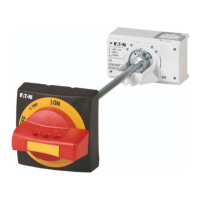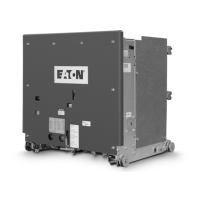Do you have a question about the Eaton NZM2 and is the answer not in the manual?
Specifies the qualified personnel for DMI installation and connection.
Details the correct installation and operational guidelines for the DMI.
Lists changes and revisions made to the manual across editions.
Describes the communication components used with NZM circuit-breakers.
Explains the DMI's role in parameter setting, operation, and monitoring circuit-breakers.
Explains how the DMI operates via keypad and menu system.
Details the primary entry point for accessing DMI submenus and displays.
Provides information on the trip, alarm, power supply, and type of connected circuit-breaker.
Details the communication status (OK/Err) and firmware version of the DMI.
Allows access to password settings and language selection for the DMI.
Details how to connect fieldbus modules to the DMI using EASY-LINK.
Outlines requirements for DMI installation to ensure EMC compliance.
Details the procedure and expected behavior when switching on the DMI for the first time.
Guides users on navigating the Display menu to view specific data.
Describes the complex Input menu for setting and parameter assignment options.
Details how to set or change the DMI's password for menu access.
Explains how to interrogate and transfer the time and date settings.
Covers scanning and setting the serial number for stop mode.
Describes how to add important parameters and data to the standard display.
Explains the automatic appearance and configuration of the DMI's standard display.
Describes the complex Input menu for setting and parameter assignment options.
Details how to set or change the DMI's password for menu access.
Specifies the DMI's motor starter functions and options.
Explains the assignment and behavior of outputs Q4 and Q5 for remote operation.
Determines the function of the I0 input for trip acknowledgement or motor protection alarm.
Informs about incompatible DMI and communication module firmware versions.
Details how to interrogate trip or alarm conditions, power supply, and circuit-breaker type.
Provides information for identification of the circuit-breaker.
Shows if circuit-breaker power supply is sufficient and if external source is used.
Displays the operating hours for the DMI and connected NZM circuit-breaker.
Shows the switching operations count for the connected NZM.
Provides solutions for common problems like 'No display' or 'Start Com display'.
Specifies required tools and cable dimensions for DMI connections.
Details the DMI's rated voltage, permissible range, and power dissipation.
Specifies mechanical operations and switching frequencies for DMI relays.
Details the number, status display, and voltage ratings of DMI digital inputs.
Explains how the NZM-XDMI-DPV1 communicates as a slave in PROFIBUS-DPV1 systems.
Describes the DMI as a slave area with DPV1 interfacing in a DP network.
Specifies the minimum DMI operating system version required for the interface.
Lists the functionalities enabled by the interface, DMI, and circuit-breaker combination.
Details the process of configuring the PROFIBUS-DP communication line.
Describes transferring the configuration to the DP master for network operation.
Instructions for starting the PROFIBUS-DP master to establish communication.
Explains preconditions for auxiliary switches and remote operators in cyclic data exchange.
Details additional info and control for motor starter functions with Module 3.
Allows accepting commands directed to the circuit-breaker or DMI.
Lists the functionalities enabled by the process data objects.
Explains the information readable via acyclic data exchange with masters.
Lists objects related to DMI output assignment, display, settings, clock, inputs, outputs, and identification.
Lists objects related to commands, communication status, and statistic values.
Describes diagnosis records containing circuit-breaker event data.
Provides API, slot number, and index for addressing diagnosis records.
Displays address location and meaning of diagnosis object data.
Provides API, slot number, and index for addressing the status object.
Displays address location and meaning of new parameters object data for writing.
Displays address location and meaning of device identification object data.
Provides API, slot number, and index for addressing the command object.
Details the hexadecimal command codes, their effects, and preconditions.
Contains the present current values of the connected circuit-breaker.
Contains the current standard display assignment of the DMI.
Lists possible meanings displayed in the DMI's standard display.
Explains how motor starter and motor states are displayed.
Describes how the current state of DMI inputs and outputs is represented.
Contains current basic setting assignments for password, language, and representation.
Displays address location and meaning of DMI basic settings object data.
Displays address location and meaning of DMI clock object data.
Indicates the BCD coding format for DMI time and date data.
Displays address location and meaning of NZM-XDMI-DPV1 device ID object data.
Displays address location and meaning of statistic values object data.
Details ambient temperature ranges and condensation requirements for DMI operation.
Lists EMC standards for electrostatic discharge, electromagnetic fields, and bursts.
Specifies required tools and cable dimensions for DMI connections.
Details the DMI's rated voltage, permissible range, and power dissipation.
| Number of poles | 1, 2, 3, 4 |
|---|---|
| Type | Molded case circuit breaker |
| Rated operational voltage | 690V AC |
| Mounting | Fixed |
| Standards | IEC |
| Tripping characteristics | Thermal-magnetic |












